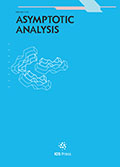Authors: Mizoguchi, Noriko | Souplet, Philippe
Article Type:
Research Article
Abstract:
The Cauchy–Dirichlet problem for the superquadratic viscous Hamilton–Jacobi equation (VHJ) from stochastic control theory, admits a unique, global viscosity solution. Solutions thus exist in the weak sense after appearance of singularity, which occurs through gradient blow-up (GBU) on the boundary. Whereas viscosity solution theory has been extensively applied to many PDEs, there seem to be less results on refined singular behavior of solutions. Although occurrence of two types of GBU, with or without loss of boundary condition (LBC), are known, detailed behavior after GBU has remained open except for a strongly restricted special class of one dimensional solutions. In
…this paper, in general dimensions, we construct solutions which undergo GBU with LBC arbitrarily many times and then recover regularity, as well as solutions without LBC at first GBU time. In one space dimension, we obtain the complete classification of viscosity solutions at each time, which extends to radial case in higher dimensions. Furthermore we show the existence of solutions exhibiting an arbitrarily given combination of GBU types with/without LBC at multiple times, in which a new type of behavior called “bouncing” is discovered. Global weak solutions of VHJ with multiple times singularity turn out to display larger variety of behaviors than in Fujita equation. We introduce a method based on an arbitrary number of critical parameters, whose continuity requires delicate arguments. Since we do not rely on any known special solution unlike in Fujita equation, our method is expected to apply to other equations. Singular behaviors at multiple times are completely new in the context of VHJ but also of stochastic control theory. Our results imply that for certain spatial distributions of rewards, if a controlled Brownian particle starts near the boundary, then the net gain attains profitable values on different time horizons but not on some intermediate times.
Show more
Keywords: Viscous Hamilton–Jacobi equation, gradient blow-up, loss and recovery of boundary conditions, multiple time singularities, viscosity solutions, zero-number, critical parameters, stochastic control
DOI: 10.3233/ASY-221813
Citation: Asymptotic Analysis,
vol. 133, no. 3, pp. 291-353, 2023
Price: EUR 27.50





